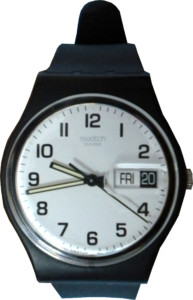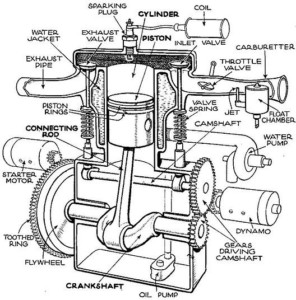 Design for manufacturing (DFM) and design for assembly (DFA) or its combination, design for manufacturing and assembly (DFMA), as well as its many design for X variants are a way to improve a design beyond its mere functionality. In my last post I gave you a basic introduction. This post will look at the prerequisites for organizing a design for X workshop. Subsequent posts will look at the different questions you can ask to further design for manufacturing and assembly.
Design for manufacturing (DFM) and design for assembly (DFA) or its combination, design for manufacturing and assembly (DFMA), as well as its many design for X variants are a way to improve a design beyond its mere functionality. In my last post I gave you a basic introduction. This post will look at the prerequisites for organizing a design for X workshop. Subsequent posts will look at the different questions you can ask to further design for manufacturing and assembly.
Which Part to Analyze and For What

Design for manufacturing (DFM), assembly (DFA)(DFMA), or inspection (DFI) is usually done for only a few parts or products at a time. Hence, the first step is to decide which parts to look at. The most interesting parts are naturally parts that have a large production volume, or a large share of the revenue or expenses. There is just more potential to optimize the high runners than the exotics.
You can look at a single part at a time, or multiple parts. In the latter case, don’t overdo it. The number of parts you can look at depends on the complexity and similarity of the parts. If it is a simpler product like a faucet, you probably can look at multiple similar products in one workshop. If it is a more complex product like a dishwasher, you may look at only one product at a time. If it is even more complex like a car, you may look only at components but not the entire car.
Overall, you have to judge how much a team can look at and consider reliably within the time for the workshop. The goal is to go more into depth rather than width to find improvement potentials.

For each part you want to analyze, you should go through the bill of materials and look at every part or component. Ideally, not only once, but in multiple iterations to see if an idea for another part later on can also be used for a previous part that was already looked at.
When to Do It
 Design for manufacturing can be done anytime, but it makes the most sense during the design process. Ideally, you already have drafted but not yet refined a design when you improve it for manufacturing. It is also possible to do this with a more complete design, although in this case you may have to redo previous design efforts to make the part easier to produce. On the other hand, this has the advantage that a more complete design allows you to see more problems.
Design for manufacturing can be done anytime, but it makes the most sense during the design process. Ideally, you already have drafted but not yet refined a design when you improve it for manufacturing. It is also possible to do this with a more complete design, although in this case you may have to redo previous design efforts to make the part easier to produce. On the other hand, this has the advantage that a more complete design allows you to see more problems.
You can also do a design for manufacturing for completed parts that are already in production. The benefit is here that production already has lots of experience with the part, and knows a lot of the problems, and maybe even some ideas on how to improve it! On the other hand, any design change involves an often lengthy process in changing the plans, changing the tools, adjusting the standards, recalculating the costs, and many more. Nevertheless, it can be worth it, and I have done successful design for manufacturing workshops for parts that were already on the market for some time.
More Than Just a Checkbox

In some companies, design for manufacturing is a mandatory checkbox on the design checklist, which then dutifully gets checked by a (probably also overworked) designer after thinking about it for less than a minute. The formalities are satisfied, but the part is still the same as before.
Real design for manufacturing will take more time, and is usually a group effort. It takes at least half a day to analyze a part and determine the potentials. And this does not even include the actual change of the design, which follows afterwards.
The Challenge of People Working Together
One of the underlying problems is that often designers and manufacturers live in different corners of their corporate world. Designers know little about the problems of manufacturing. Similarly, manufacturers know little about the problems of designers. A good design for manufacturing workshop can also help to educate one side about the problems of the other side and vice versa. I had examples where the workshop was quite eye opening both for the designers and the manufacturers.
Hence, to optimize a design for manufacturing, assembly, or inspection, you would need to get a small group of people together to look at the part in question. The benefit is in bringing both design knowledge and manufacturing and assembly knowledge or even inspection knowledge into the same room. Especially in larger companies, the design department has little interaction with the production and vice versa. I’ve had, for my taste, way too many experiences where the design department just dumped the design on manufacturing, and then it was no longer really their problem but the problem of manufacturing.
Since it is an additional effort for the design department with benefit primarily for manufacturing, manufacturing is usually all for it, but design is quite hesitant. Especially since sometimes manufacturing uses the opportunity to blame design for everything that went wrong in the past, which of course upsets design. Therefore, making a design for manufacturing workshop should involve people from different departments, and should be initiated by some higher-ups who have hierarchy over both the design and the manufacturing department.
A typical team often involves one or two designers of this product, one or two people manufacturing and assembling this product (both operator and supervisor), a person from the construction of the corresponding machines and tools, a person from service if you want to include service, and maybe a manager or moderator. The emphasis is on participants from manufacturing and/or assembly, as they bring crucial knowledge to the workshop. A team consisting only of designers will give a much smoother and conflict-free workshop, but will miss out on much of the improvement potential.
Bring Samples and Documentation

It is really helpful for a design for manufacturing workshop to have samples of the products to look at and to disassemble. It is even better if you also have products from the competition too. Make sure you also have some tools to take them apart. Depending on your or your competitors product, you should make it clear if some parts must not be damaged, although it is easier if all parts are replaceable and can be ripped apart. If you need bigger tools like a band saw, make sure they are available and there is someone who knows how to use it.
It is also necessary to have the bill of materials (if it is an assembly process) and the process sequence or work instructions. Going through these step by step gives a lot of ideas for improvement.
Caveats
There are a few common mistakes when doing a design for manufacturing workshop. The goal is to optimize the overall cost, not only the cost of the part. There will be instances when a more-expensive part can make the total cost go down because it is easier to manufacture or assemble. The challenge here is that these cost relations are often not clearly visible and depend a lot on guesstimates.
Functionality has priority! Even with the cost savings, the part should still work as intended. Saving money and making products that no longer work doesn’t save money at all. However, be aware that there is often a gray zone, where more of something would be better for functionality, but it would still work without. If the discussion gets heated, some may exaggerate and claim that a minor change in something will totally ruin the product. Maybe they are right, maybe not.

My common example for this is a coating for a pump in a luxury brand automobile that prevents surface rust, but costs €1 per pump. The functionality is not hindered, and most customers will never even see the pump unless they crawl underneath their car. Nevertheless, there was a lot of argument for the coating with the claim that rust may damage the brand reputation.
Summary
The steps above will help you to organize a successful design for manufacturing workshop. For more details on creative problem solving, see my post on My Workshop Structure for Creative Problem Solving.
In my next posts I go into the actual questions that you should ask (repeatedly) during a design for manufacturing workshop. Until then, stay posted. Now, go out, consider which parts can be produced easier, and organize your industry!


1 thought on “Design for Manufacturing and Assembly Workshop Preparation”